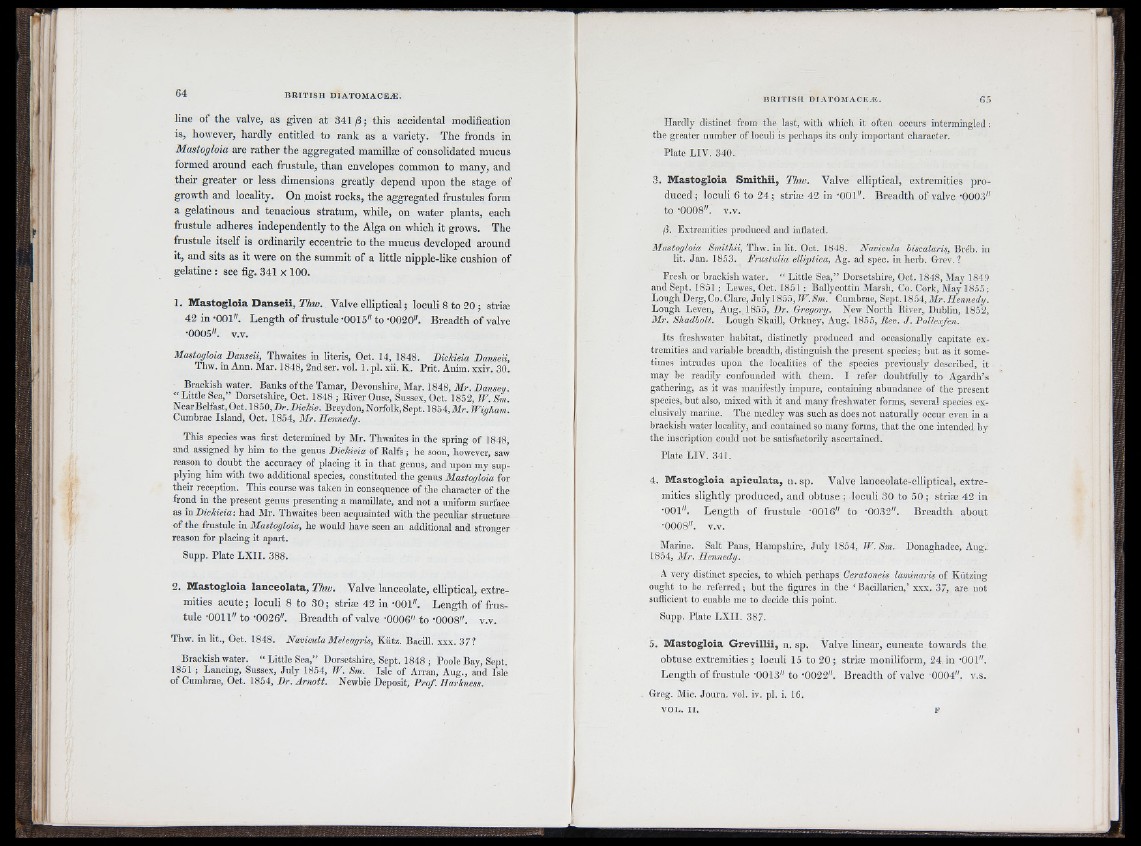
line of the valve, as given at 3 4 1 ^ ; this accidental modification
is, however, hardly entitled to rank as a variety. The fronds in
Mastogloia are rather the aggregated mamillæ of consolidated mucus
formed around each frustule, than envelopes common to many, and
their greater or less dimensions greatly depend upon the stage of
growth and locality. On moist rocks, the aggregated frustules form
a gelatinous and tenacious stratum, while, on water plants, each
frustule adheres independently to the Alga on which it grow's. The
frustule itself is ordinarily eccentric to the mucus developed around
it, and sits as it were on the summit of a little nipple-like cushion of
gelatine : see fig. 341 x 100.
1. Mastogloia Danseii, 77iW. Valve elliptical ; loculi 8 to 2 0 ; striæ
42 in -001". Length of frustule '0015" to -0020". Breadth of valve
•0005". v.v.
Mastogloia Danseii, Thwaites in literis, Oct. 14, 1848. DicUeia Danseii,
Thw. in Ann. Mar. 1848, 2nd ser. vol. 1. pl. xii. K. Prit. Anim. xxiv. 30.
Brackish water. Banks of the Tamar, Devonshire, Mar. 1848, Mr. Dansey.
“ Little Sea,” Dorsetshire. Oct. 1848 ; River Ouse, Sussex, Oct. 1852, W.Sm.
NearBelfast,Oct.l850,D»-.Dic/a'e. Breydon,Norfolk,Sept. 1854,Mr. Wigham.
Cumbrae Island, Oct. 1854, Mr. Hennedy.
This species was first determined by Mr. Thwaites in the spring of 1848,
and assigned by him to the genus Dickieia of Ralfs ; he soon, however, saw
reason to doubt the accuracy of placing it in that genus, and upon my supplying
him with two additional species, constituted the genus Mastogloia for
their reception. This course was taken in consequence of the character of the
frond in the present genus presenting a mamillate, and not a uniform surface
as in Dickieia: had Mr. Thwaites been acquainted with the peculiar structure
of the frustule in Mastogloia, he would have seen an additional and stronger
reason for placing it apart.
Supp. Plate LXII. 388.
2. Mastogloia lanceolata, Thw. Valve lanceolate, elliptical, extremities
acute ; loculi 8 to 30 ; striæ 42 in -001". Length of frustule
•OOll" to •0026". Breadth of valve •0006" to •0008". v.v.
Thw. in lit., Oct. 1848. Navicula Meleagris, Kiitz. Bacill. xxx. 37?
Brackish water. “ Little Sea,” Dorsetshire, Sept. 1848 ; Poole Bay, Sept.
I85I ; Lancing, Sussex, July 1854, W. Sm. Isle of Arran, Aug., and Isle
of Cumbrae, Oct. 1854, Dr. Arnott. Newbie Deposit, Prof. Harkness.
Hariily distinct from the last, with which it often occurs intermingled:
the greater number of loculi is perhaps its only important character.
Plate LIV. 340.
3. Mastogloia Smithii, Thw. Valve elliptical, extremities produced
; loculi 6 to 24 ; striæ 42 in •OOl". Breadth of valve -0003"
to -0008". v.v.
ft. Extremities produced and infiated.
Mastogloia Smithii, Thw. in lit. Oct. 1848. Navicula biscalaris, Brel), in
lit. Jan. 1853. Frustulia elliptica, Ag. ad spec, in herb. Grev.?
Fresh or brackish water. “ Little Sea,” Dorsetshire, Oct. 1848, May 1849
and Sept, 1851 ; Lewes, Oct. 1851 ; Ballycottin Marsh, Co. Cork, May 1855;
Lough Derg,Co.Clare, July 1855, W.Sm. Cumbrae, Sept. 1854,Mr.Hennedy.
Lough Leven, Aug. 1855, Dr. Gregory. New North River, Dublin, 1852,
Mr. Shadbolt. Lough Skaill, Orkney, Aug. 1855, Itev. J. Polleæfen.
Its freshwater habitat, distinctly produced and occasionally capitate extremities
and variable breadth, distinguish the present species; but as it sometimes
intrudes upon the localities of the species previously described, it
may be readily confounded with them. I refer doubtfully to Agardh’s
gathering, as it was manifestly impure, containing abundance of the present
species, but also, mixed with it and many freshwater forms, several species exclusively
marine. The medley was such as does not naturally occur even in a
brackish water locality, and contained so many forms, that the one intended by
the inscription could not be satisfactorily ascertained.
Plate LIV. 341.
4. Mastogloia apicnlata, u. sp. Valve lanceolate-elliptical, extremities
slightly produced, and obtuse ; loculi 30 to 50 ; striæ 42 in
•001". Length of frustule -0016" to -0032". Breadth about
•0008". v.v.
Marine. Salt Pans, Hampshire, July 1854, W.Sm. Donaghadee, Aug.
1854, Mr. Hennedy.
A very distinct species, to which perhaps Ceratoneis laniinaris of Kiitzmg
ought to be referred; but the figures in the ‘Bacillarien,’ xxx. 37, are not
sufficient to enable me to decide this point.
Supp. Plate LXII. 387.
5. Mastogloia Grevillii, n. sp. Valve linear, cuneate towards the
obtuse extremities ; loculi 15 to 20 ; striæ moniliform, 24 in ‘001".
Length of frustule -0013" to •0022". Breadth of valve 0004". v.s.
Greg. Mic. Journ. vol. iv. pl. i. 16.
von. I I . E